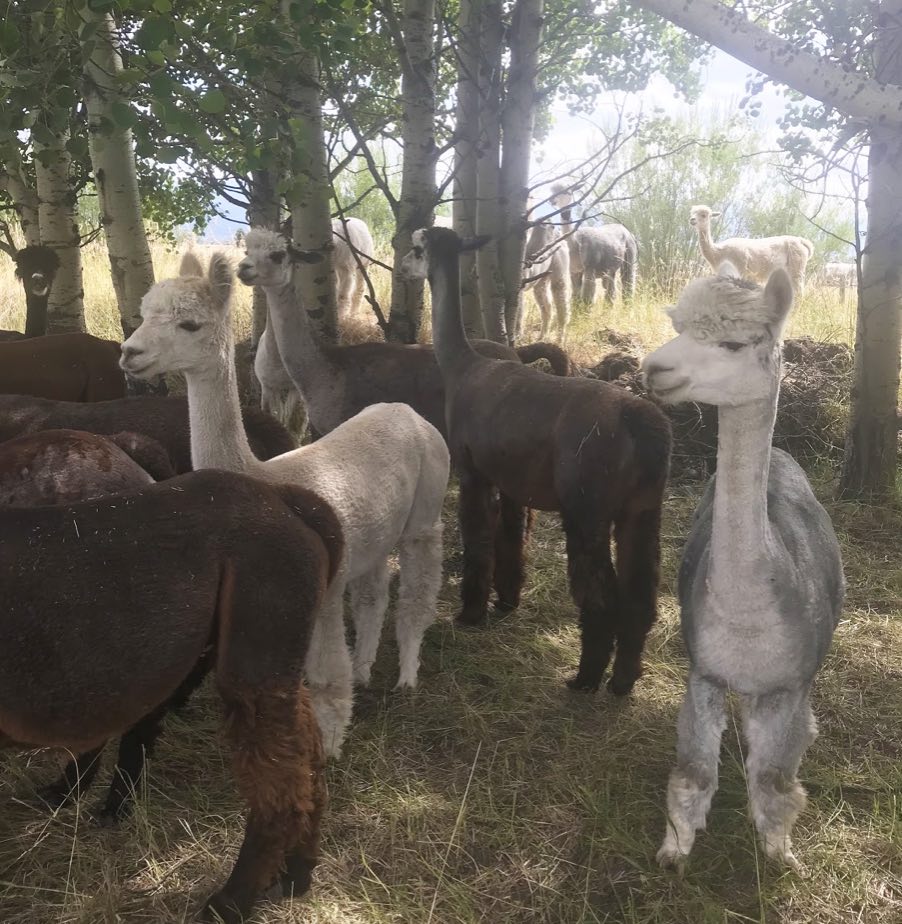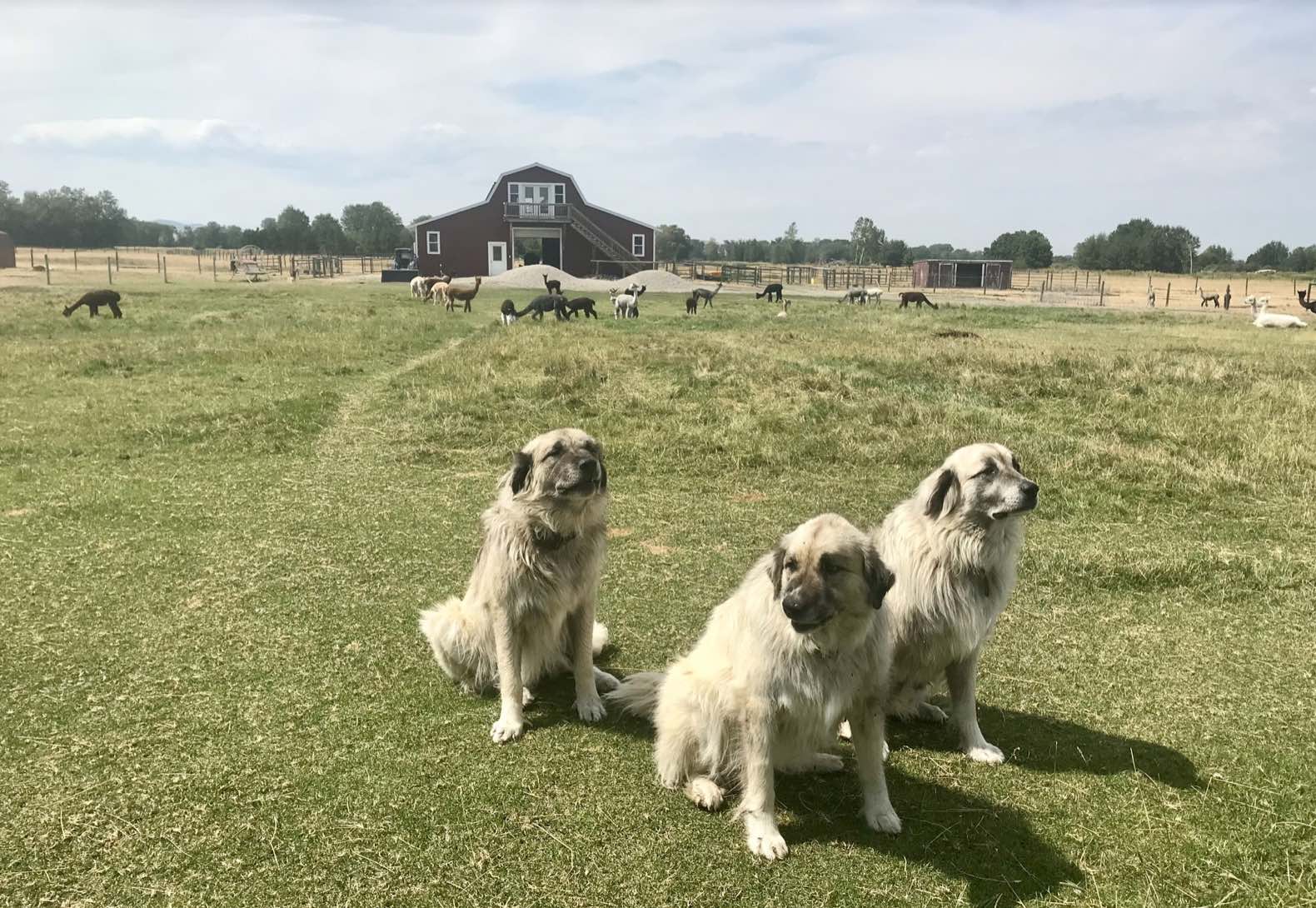Alpacas of Montana designs purposeful products, striving to become a household staple
By Mira Brody EBS STAFF
BOZEMAN – Hazel, Finn and Chili, three Turkish Anatolian Shepherds, roam the vast pastures at Alpacas of Montana on South Cottonwood Road, just south of Bozeman. At approximately 120 pounds each, these livestock guard dogs are capable of taking down a mountain lion, yet their demeanor is calm and tolerant—that is, until you threaten their herd.
Grouped around them, in fluffy shades of brown, white, black and gray, are 85 alpacas and the largest alpaca textile company in the U.S. Alpacas of Montana owners James and Sarah Budd believe that alpaca fur—what Peruvians refer to as the “gold of the Andes”—is the answer to a lot of the world’s wool woes.
Alpacas are the second newest mammal in the world and the result of breeding two different animals from two very different elevation levels. They are a domesticated member of the camelid family, originating on the plains of North America and created through breeding vicunas for their soft fur, and guanacos for the sturdiness of their fur. With these genetics, alpacas are able to grow extremely soft, yet hearty fibers for clothing.
James has a medical background, while Sarah studied psychology and when the pair were looking ahead to their next venture in life they stumbled into alpaca farming by chance. The textiles produced from alpaca fur fascinated them, and they began researching why the products were so warm and soft, yet breathable.
Armed with their knowledge and passion for alpaca products, the Budds hope to make alpaca textiles a staple in U.S. households.
“I can tell you straight up, we know more about alpaca fibers than anyone else in the world,” James Budd said. “We bank on having to know that. Now we design purposeful products. It’s not just any yarn on any product. We design the yarn first, then the product. Not the product first, then the yarn—it all starts at the baseline of ‘what is this product and what are we trying to make it do?’”
Alpaca fibers are hollow—making them naturally wicking and breathable—flame and water resistant, antimicrobial, hypoallergenic and warmer, softer and stronger than standard sheep’s wool. This makes for a world of versatility when it comes to designing tactical clothing from firefighter helmet liners, to hiking and running socks, next-to-skin clothing and even blankets and everyday wear like sweaters and hats. Their socks have even been featured in Outside Magazine’s “Best Winter Workwear of 2020.”
Adversely, most sheep’s wool is super washed and chemically treated in order to remove the lanolin and barbs that naturally occur in sheep fibers, so it feels less scratchy. This dumps chemicals such as, chlorine and hypochlorous acid and sulfuric acid, into the environment. This is the process used to make SmartWool and other Merino wool products.
“If you care about what you put on your body … because its been so heavily chemically treated, it’s no longer a natural fiber,” James said.
Alpaca wool is shaved from the animal, washed gently in Dawn soap, then spun into yarn, before becoming various textile products. Alpacas are also incredibly economically sustainable: they eat less than a half of pound of hay each day and with three stomachs, which help them to absorb all nutrients, making for great compost that the farm also sells.
James says the reason alpaca wool has not surpassed sheep’s wool as a revolutionary textile is the same reason bison meat has not surpassed the beef industry—government lobbyists.
“It’s difficult for us because we have a viable product that outperforms wool,” he said. “And when you have little to no government support, like the sheep industry has, when you have the sheep industry itself coming after us and attacking us with everything we say or do, all the way to the point of which it is inhibiting the alpaca growth in this country by far because we don’t have the true support that every industry needs in order to be successful.”
After studying the effects chemical treatments have on the quality of clothing and comparing it to alpaca, James went to the government to advocate for alpacas as a more sustainable clothing source. They wouldn’t listen. Every way the livestock industry functions seems to favor sheep over any alternative, from the tax—54 cents per sheep against $10.60 per alpaca—to the Montana State University wool lab’s refusal to test and study alpaca, to the Budd’s difficulties getting a loan when they were first started their business.
“Our own state lab won’t touch alpaca because the sheep industry won’t allow it,” Budd said. “We can’t even get state support from our university in our own town.”
The Budd’s hope is for an alpaca revolution and they say the key to making that leap is support. Alpacas of Montana hopes to soon find a partner with the resources and will to face lobbyists and pave the way for alpacas in the U.S. textile industry.

Meanwhile, James and Sarah do their best to educate the public and treat their animals with the best care possible—last year their annual open house weekend brought in 10,000 visitors of all ages from all over the country. They also set up shop in both Bozeman Ace Hardware stores during the holidays and a couple years ago they made the decision to expand their production to New Zealand, Australia, Peru and Bolivia, allowing them to reach more customers and grow as a company. They currently have 32 new alpaca fabrics designed and are working with companies like Lulu Lemon, Patagonia and Colombia to design purposeful products for everyday use.
This care and passion is reflected in a visit to their alpaca farm, where you’ll learn that alpacas greet by touching noses, that older alpacas produce more coarse fibers, that llamas, who also reside on the farm, will guard the alpacas and that each and every animal—including all 85 alpaca residents that live there now—have a name.













